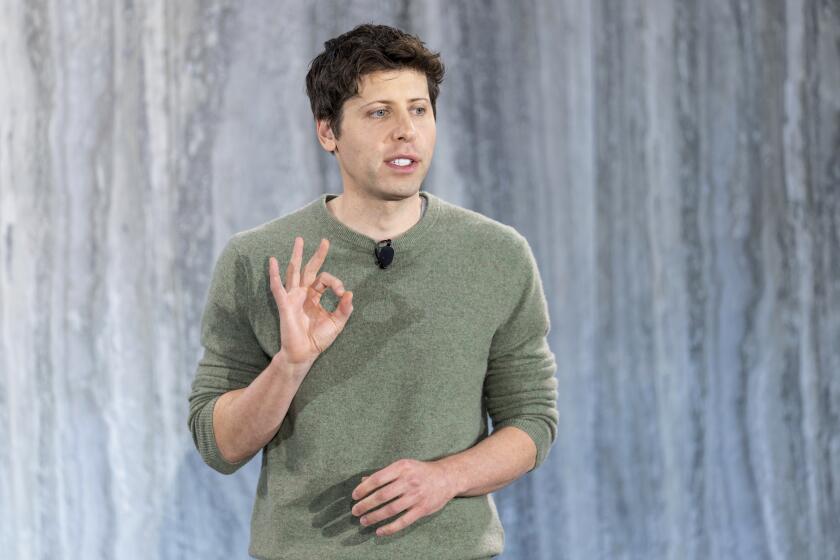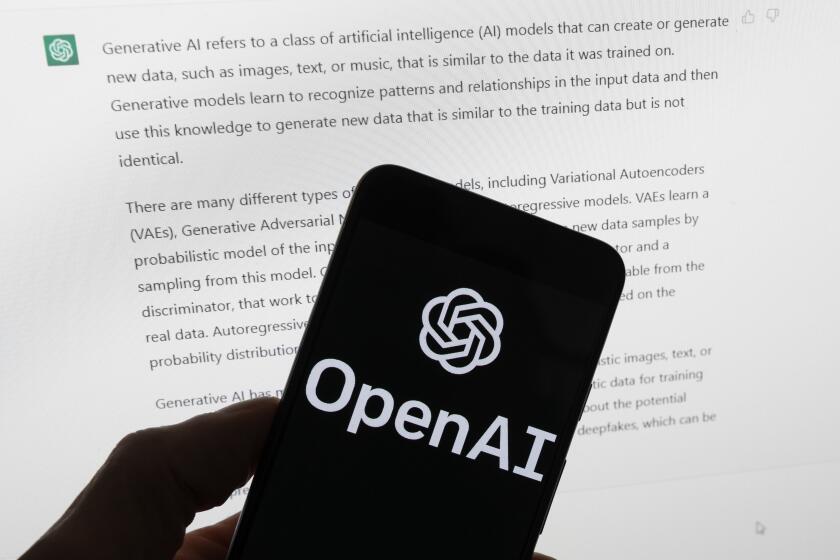Opinion: Can today’s AI truly learn on its own? Not likely

One of the boldest, most breathless claims being made about artificial intelligence tools is that they have “emergent properties” — impressive abilities gained by these programs that they were supposedly never trained to possess. “60 Minutes,” for example, reported credulously that a Google program taught itself to speak Bengali, while the New York Times misleadingly defined “emergent behavior” in AI as language models gaining “unexpected or unintended abilities” such as writing computer code.
This misappropriation of the term “emergent” by AI researchers and boosters deploys language from biology and physics to imply that these programs are uncovering new scientific principles adjacent to basic questions about consciousness — that AIs are showing signs of life. However, as computational linguistics expert Emily Bender has pointed out, we’ve been giving AI too much credit since at least the 1960s. A new study from Stanford researchers suggests that “sparks” of intelligence in supposedly “emergent” systems are in fact mirages.
If anything, these far-fetched claims look like a marketing maneuver — one at odds with the definition of “emergence” used in science for decades. The term captures one of the most thrilling phenomena in nature: complex, unpredictable behaviors emerging from simple natural laws. Far removed from this classic definition, current AIs display behaviors more appropriately characterized as “knowledge sausage”: complex, vaguely acceptable computer outputs that predictably arise from even more complex, industrial-scale inputs.
ChatGPT and other new AI services benefit from a science fiction-infused marketing frenzy unlike anything in recent memory. There’s more to fear here than killer robots.
The language model training process used for AI takes gigantic troves of data scraped indiscriminately from the internet, pushes that data repeatedly through artificial neural networks, some containing 175 billion individual parameters, and adjusts the networks’ settings to more closely fit the data. The process involves what the chief executive of OpenAI has called an “eye-watering” amount of computations. In the end, this immense enterprise arrives not at an unexplained spark of consciousness but a compressed kielbasa of information. It is the industrial production of a knowledge sausage, which crams together so much data that its ability to spit out a million possible outputs becomes relatively quotidian.
Contrast this with examples of actual emergence, such as fluid flow, which has been described for two centuries by an elegant expression known as the Navier-Stokes equations. Shorter than a haiku, these equations somehow characterize a stupendous range of natural phenomena, from steam rising from a coffee mug to the turbulent vortices of weather systems hundreds of miles wide. None of this is obvious from inspecting the equations. Yet they spontaneously give rise to beautiful, interlocking systems of complex whorls.
In my more than two decades researching computational methods for harnessing these equations (and translating some of my findings into algorithms that appeared in “Avatar” and “Iron Man 3,” winning me an Academy Award), I’ve seen this beauty and complexity emerge repeatedly. It’s far removed from the workings of today’s AI.
Additional examples of emergent behavior in physics and biology include four-line descriptions of water and ice that suddenly give rise to intricate snowflake patterns (the subject of my PhD dissertation). Another is the reaction-diffusion systems discovered by Alan Turing, the same British scientist who developed the infamous “Turing test” to gauge whether AIs are indistinguishable from humans. He found simple systems of equations describing chemical interactions that spontaneously organize into the spots of a leopard or stripes of a zebra.
When recognizable biological structures spring forth from primordial chemical baths, it points toward a better understanding of one of humanity’s most basic questions: How did life begin? Scientists have been enchanted for centuries whenever such simple mechanisms produce such complex phenomena, understandably treating them with near-religious awe. When magic emerges from a haiku-like equation or primordial ooze, we get to witness something rise up from practically nothing. With OpenAI’s ChatGPT and Google’s Bard, we’re seeing an industrial product rising up from a factory complex.
The panic over products from OpenAI and other companies says more about our cultural moment than about the tech itself.
Just as with real-life sausage, the components that make up ChatGPT are obscured over the course of its production. But that doesn’t mean they defy explanation, especially by manufacturers. After the “60 Minutes” broadcast, Margaret Mitchell, an AI ethics researcher Google fired two years ago, pointed out that Google’s program could speak Bengali because it was almost certainly shown Bengali while being trained and used pieces of a previous model that already knew the language. The suggestion that it acquired this skill ex nihilo strains credulity.
The “emergent” claims of AI writing computer code have equally mundane explanations: There are massive amounts of code on the internet. When shown the contents of the internet over and over, the AI learns both written and programmed languages.
Downplaying such mundane provenances feeds the notion that AIs must somehow be magical. As digital humanities scholar Lauren Klein explained in a recent talk, this narrative that code is magic and its creators akin to wizards stretches back to the 1950s. Programmers considered themselves “members of a priesthood guarding skills and mysteries far too complex for ordinary mortals.” Today, with coding skills being taught on college campuses around the world, this illusion has become harder to maintain. AI is being spun into the fabric that clothes the new priesthood.
Claiming that complex outputs arising from even more complex inputs is “emergent behavior” is like finding a severed finger in a hot dog and claiming the hot dog factory has learned to create fingers. Modern AI chatbots are not magical artifacts without precedent in human history. They are not producing something out of nothing. They do not reveal insights into the laws that govern human consciousness and our physical universe. They are industrial-scale knowledge sausages.
Theodore Kim is an associate professor of computer science at Yale University. @_TheodoreKim
More to Read
A cure for the common opinion
Get thought-provoking perspectives with our weekly newsletter.
You may occasionally receive promotional content from the Los Angeles Times.












